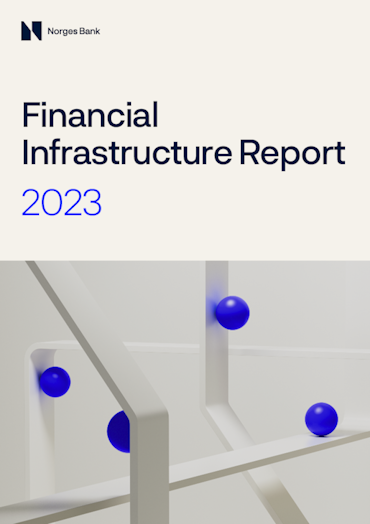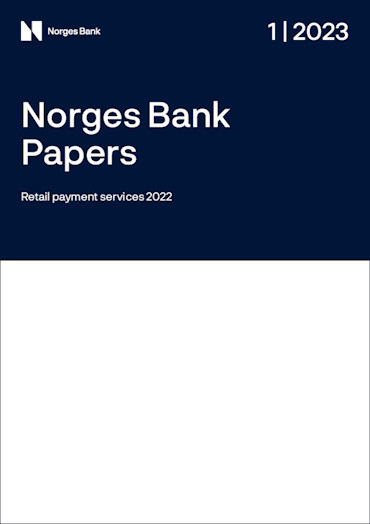Financial infrastructure 2023
The payment system and other financial infrastructure are secure and efficient. At the same time, the payment system is in need of further enhancement and contingency arrangements need to be strengthened, so that the public can also continue to pay securely and efficiently in NOK in the future.
Contingency arrangements in the payment system need to be strengthened
The financial infrastructure in Norway is secure and efficient. At the same time, the payment system is in need of further enhancement and contingency arrangements need to be strengthened, so that the public can also continue to pay securely and efficiently in NOK in the future.
Today, Norges Bank is publishing Financial Infrastructure Report 2023 and Norges Bank Papers 1/2023, “Retail payment services 2022”.
“Risks have intensified and the threat landscape has expanded. Maintaining a secure payment system requires the efforts of individual entities and effective public-private cooperation. Cyber incidents can quickly spread across sectors, and contingency work in the various sectors must therefore be viewed in a broader context”, says Deputy Governor Pål Longva.
Norges Bank and Finanstilsynet (Financial Supervisory Authority of Norway) have introduced a framework for testing the cyber resilience of the banking and payment systems. Testing, which simulates real attacks, is now under way. The purpose is to strengthen the cyber resilience of financial sector entities and thus promote financial stability.
The evolving payment landscape is marked by new technology, new payment methods and new payment providers.
“We will face important choices when designing the payment system. Over the coming years, Norges Bank will study and decide on the future design of Norges Bank’s settlement system. At the same time, we are stepping up our work on a central bank digital currency”, says Deputy Governor Pål Longva.
There is ongoing work world-wide to develop and establish regulation for crypto-asset markets, but it is uncertain how long this will take.
“The Norwegian authorities should assess whether to proceed more quickly rather than wait for international regulatory solutions. Norges Bank can contribute to such assessments and to regulation that promotes responsible innovation”, says Deputy Governor Pål Longva.
Financial Infrastructure Report 2023 – In a nutshell
Cyber testing under a new framework is under way
Norges Bank and Finanstilsynet (Financial Supervisory Authority of Norway) have introduced a framework for testing the cyber resilience of the banking and payment systems. Testing, which simulates real attacks, is now under way. The purpose is to strengthen the cyber resilience of financial sector entities and thus promote financial stability.
The need for independent contingency arrangements should be assessed
Risks have intensified and the threat landscape has expanded in recent years, and it should be assessed whether, in addition to cash, contingency arrangements that are more independent of the ordinary payment system are needed. Such arrangements would come in addition to the individual financial market infrastructure’s continuity and contingency plans. Norges Bank will engage in dialogue with other authorities and the industry on this issue.
Having an array of payment options increases consumer preparedness
The consequences for consumers of technical disruptions of the payment system would be less serious if consumers have an array of payment options. These may be different types of payment cards, accounts in more than one bank and some cash available.
Norges Bank is studying the settlement system of the future
Interbank payments in NOK are settled with finality in Norges Bank’s settlement system. In the coming years, the Bank will study and decide on the future design of Norges Bank’s settlement system. A key question is whether it will build on the current model or whether other solutions, such as participation in the Eurosystem’s TARGET2 system, are more appropriate.
Work on a CBDC is being stepped up
Norges Bank is now stepping up its efforts to study whether the public should have access to a central bank digital currency (CBDC) in addition to cash. In the period to 2025, the Bank will analyse the possibilities afforded by a CBDC and its impact and test and evaluate candidate solutions.
The authorities should consider a national strategy for regulating crypto-asset markets
There is ongoing work world-wide to develop and establish regulation for crypto-asset markets, but it is uncertain how long this will take. The Norwegian authorities should assess whether to proceed more quickly rather than wait for international regulatory solutions. Norges Bank can contribute to such assessments and to regulation that promotes responsible innovation.
Financial infrastructure 2023
Les rapporten her (nettformat)- Series:
- Financial Infrastructure Report
- Number:
- 2023
Corrected version published 5 June 2023: Corrections have been made to “Selected Key figures” and table 2 in the Annex. The figure “Daily turnover in Norges Bank’s settlement system” has been corrected to NOK 338.6bn, and “RTGS Gross transactions excl. NICS” has been corrected to NOK 114.0bn.

Retail payment services 2022
Read the report (web edition)- Series:
- Norges Bank Papers
- Number:
- 1/2023
- Norway is one of the countries in the world with the highest annual use of payment cards per inhabitant. On average, each Norwegian used a card 531 times in 2022.
- In 2022, 86 percent of payments made at physical payment terminals were contactless. The vast majority of these payments were made with physical cards. Even though the number of payments using mobile phones, watches or wristbands has multiplied over the past two years, they still only account for approximately 6 percent of contactless payments at physical payment terminals and about 4 percent of all payments at physical payment terminals.
- For several years, card use for online purchases has risen sharply. Card use abroad and the use of different mobile payment apps at physical points of sale (POS) has also recently shown a sharp increase. This has contributed to an increase in the market share of international cards because only they can be used in such payment situations. In 2022, international cards accounted for 43 percent of card payments, up from 37 percent in 2021.
- Cash use has fallen over a long period but has remained stable in most recent years. Norges Bank’s latest survey shows that 3 percent of survey participants used cash in their most recent payments at physical points of sale. Despite low cash use, demand for cash has increased over the past year. For the first time in a long time, the number of ATM and POS withdrawals edged up.
Corrected version published 1 June 2023: I chapter 2, the sentence "Of these payments, 318 million were made with a physical card, while 118 million were made using mobile phones, watches or wristbands” is corrected to "Of these payments, 323 million were made with a physical card, while 113 million were made using mobile phones, watches or wristbands.”
